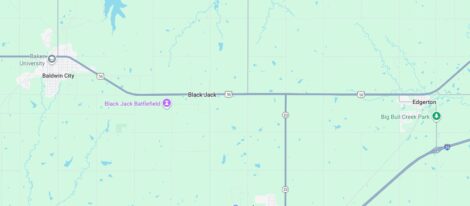Kansas reports 17,000 lead pipes in initial count, far fewer than federal estimates; here’s what that looks like in Douglas County

photo by: Brian Grimmett/Kansas News Service
Kansas has compiled initial statewide data revealing how many lead pipes still deliver drinking water — an urgent step in former President Joe Biden’s push to replace them within the next decade.
Currently, state data estimates that approximately 17,000 lead pipes still carry water from public supplies to private properties in Kansas — significantly fewer than the Environmental Protection Agency’s estimate of 54,000 and far below the Natural Resources Defense Council’s estimate of 160,000.
“It was a good surprise,” Rob Gavin, compliance and data management unit chief at the Kansas Department of Health and Environment, said. ” … We don’t have near as many lead pipes as was predicted.”
But cities still haven’t finished counting in several parts of the state, Gavin said, and these numbers will continue to be updated.
“(Cities and other municipalities) should be updating it as they find anything or go out and replace any lines,” Gavin told the Journal-World. “They should be updating their lead service line inventories.”
Lead is a powerful neurotoxin, and according to the Centers for Disease Control and Prevention, there is no safe level of exposure and no cure for lead poisoning once it occurs. A public health crisis happened in Flint, Michigan, after the city switched to the Flint River for its water supply. The change resulted in lead contamination due to the absence of corrosion control treatment, and it exposed thousands of residents to dangerous lead levels and an outbreak of Legionnaires’ disease, a serious type of pneumonia.
In kids, lead can impair both mental and physical development and may lead to permanent brain damage. Adults exposed to lead face increased risks of high blood pressure, heart disease, kidney damage, and even cancer.
During his last term, President Donald Trump revised the Environmental Protection Agency’s Lead and Copper Rule, which regulates lead and copper levels in drinking water. He extended lead pipe replacement timelines from 14 to 33 years and set a new 10 parts per billion “trigger level,” with action required only above 15 ppb.
In response to these changes, the Biden administration announced changes of its own in October, issuing a ruling requiring drinking water systems across the country to identify and replace lead pipes within 10 years and lowered the lead action level from 15 ppb to 10 ppb.
As of early 2025, Trump and Republican lawmakers have expressed intentions to repeal the changes using the Congressional Review Act. This move aims to reinstate the Trump-era revisions, which they argue would reduce regulatory burdens and costs for utilities. However, environmental groups contend that such a rollback would compromise public health protections, particularly for vulnerable communities.
But no action has been taken by the Trump administration to change the new timeline of lead service line replacements.
Biden’s Lead and Copper Rule Improvements also require more testing for drinking water and a lower threshold requiring communities to take action to protect people from lead exposure in water. The ruling also improved communication between communities so that people can learn about the risks of lead in drinking water, the location of lead pipes and plans for replacing them.
As a part of the improvements, the EPA put aside $2.6 billion in drinking water infrastructure funding through the Bipartisan Infrastructure Law. This funding will flow through the drinking water state revolving funds and is available to support lead pipe replacement and inventory projects.
There have been a couple of lawsuits over these changes to the lead and copper rule, such as the one filed by the American Water Works Association, a water utility business group, in December 2024. The group argued that the new rule is unreasonably costly and potentially unfeasible for many utilities to meet, like in Chicago, where it’s estimated to have approximately 400,000 remaining lead service lines.
However, Kansas doesn’t seem to be having as big of a problem. States were required to submit an initial count of lead service line data to the EPA on Oct. 16, 2024. Following the data collection, water systems are required to notify homeowners about the results of their property’s lead and copper sampling.
KDHE then reviews the data to ensure compliance with federal regulations and may require additional actions like increased monitoring or public notices if the maximum contaminant levels or action levels are exceeded.
While the number of lead service lines identified so far in Kansas may seem relatively small on its own, there are 59,980 galvanized service lines – pipes that were, or still are, connected downstream from lead service lines or lines with unknown material – that also need replacement, along with 226,420 lines made of unknown materials.
The 226,420 gap could represent service lines made of lead, galvanized steel, or other non-lead materials, and there are a total of 924,028 service lines across the state, according to data from the KDHE.
“The most common situation in Kansas is that the utility owns … from the water main to the meter, and then from the meter into the home, the residence structure is put in by a plumber,” Gavin said. “And so, there’s no record of what that is other than depending on what plumbing codes were in place at the time.”
“It’s kind of hard to replace them if you don’t know where they’re at (and) don’t know what materials are there,” Gavin said.
Service lines in Lawrence
The City of Lawrence has a total of 31,276 service lines running through the city – and 99% of them are non-lead service lines. To reach these figures, Josh Toevs, water quality lab manager at the city, pointed out that the statewide data from the KDHE contained errors in the numbers. He provided the “corrected City of Lawrence numbers from the initial inventory” in an email.
“The LSLI numbers were accidentally transposed when entered into the database,” Toevs said via email.
According to corrected numbers, there are two lead service lines that remain in the city. These service lines are on the private side – the portion of the pipe that connects the water meter to the inside of a home or building – of 944 Vermont St. and 612 Louisiana St.
“These locations were determined from our customer surveys and (may) not be accurate — our attempts to follow-up on these locations have not been responded to yet,” Michael Leos, a city spokesperson told the Journal-World via email. “We have recorded them as lead-based from the last information we received from those customers.”
In addition, Lawrence has 130 galvanized pipes requiring replacement.
There is one service line identified as unknown in Lawrence, and it is attached to a meter on a roundabout on Queens Road and Wakarusa Drive. Toevs said this could be because it doesn’t have an address and was missed while collecting inventory the first time around. He said this should be corrected in the next round of inventory efforts.
Service lines in Douglas County
Lecompton
Lynley Sanford, city clerk of Lecompton, told the Journal-World in an email that “at this time, there are no lead service lines that we are aware of that need to be replaced.” And if the City of Lecompton was looking for financial assistance to help with the replacements, they would consider sources for grant funding through the state and federal government.
Sanford said that one of the challenges that has arisen from these efforts have included identifying the types of service lines on the customer side of the water meter and inside residential homes.
“There are many home owners who do not want the city to inspect the water supply lines coming into their homes and running to the faucets in the kitchens or bathrooms,” Sanford said. “In these instances, it is difficult to complete the required inventory inspection.”
While Lecompton has no reported lead and galvanized service lines that need replacement, it does report 69 unknown service lines, and Sanford said this is because of individuals who either would not let staff into their homes to inspect the residential side of the utility or did not understand what the inventory survey was asking.
“The city will continue to reach out to those residences and offer to inspect the residential side if they will allow us access,” Sanford said. ” … Until we can view the home owner side of the supply lines the city will continue to provide “potential” lead exposure risk notices to the property owner as required by the EPA.”
Eudora
The City of Eudora has 2,437 service lines, and Kevyn Gero, city manager of Eudora, said via email that the city has either visually inspected or confirmed 656 service lines from construction drawings and found that zero of those had a lead or unknown status.
The data from the KDHE also noted that 1,781 service lines were identified as unknown, and Gero said this figure represents the number of services that still have not been inspected.
“City staff (continue) to inspect service lines during their regular duties, and no lead or unknown services have been found,” Gero said. “If a lead service line is discovered, we will update the inventory with KDHE.”
Baldwin City
According to the data from the KDHE, Baldwin City has nine galvanized service lines requiring replacement and three unknown service lines.
“We submitted our lead line service inventory to KDHE complete and on time,” Lynn Meador, communications director at Baldwin City, said via email. She did not comment on the collection of data itself or how the city would handle service line replacements if needed.
Douglas County Rural Water Districts
According to data from the KDHE, Douglas County Rural Water District 1 reported no lead service lines and identified 418 service lines as non-lead. District 2 reported the most lead pipes with 185 lead service lines and 278 non-lead. District 3 listed 1,019 service lines as unknown and 957 as non-lead. District 4 reported 36 galvanized service lines, 1,277 unknown, and 20 non-lead. District 5 identified 24 unknown service lines and 1,087 non-lead. District 6 reported 51 unknown service lines and one non-lead.
None of the Douglas County Rural Water Districts responded to requests for comment.
What happens now?
Toevs said that in terms of service line replacement, he thinks the City of Lawrence is in a fortunate position where a lot of the water mains and service line materials have been replaced since lead service lines were banned.
“We’re certainly not facing a huge project to get those replaced,” Toevs said. “I think we can say we’ve acted.” By 2027, Toevs said the city needs to submit plans in place for service line replacements.
“So any of those galvanized lines require replacement … (we need) to replace the ones that we are legally able to access, so that’s kind of top of the list,” Toevs said.
To fund these replacements, Toevs said the city does have money already budgeted, and that all of the money that is meant to go toward this effort has been budgeted within the city’s utility rate model.
The initial inventory collected was finalized in March of this year, but data was required to be sent by Oct. 16, 2024. Gavin said cities will have to then submit another set of data known as a “baseline inventory” on Nov. 1, 2027. Gavin said once this inventory is submitted, there will be annual updates every year for all the cities nationwide.
“If they’re doing sampling during this interim period, they would turn in any updates and mark what sample sites they’re going to do, so we know where they’re sampling,” Gavin said.







